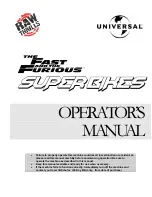
LIO-8 Users Guide
92
The LIO-8 ships with a world-ready 24 volt, 2 amp power supply. You can plug this supply into any AC power
source from 90V to 240V, 50Hz - 60Hz, using an appropriate IEC power cord, and it will supply the proper
power to the LIO-8 on the 4 pin XLR power connector. The LIO-8 will not supply power to the FireWire bus,
but will pass power coming from other devices.
As with all electronic devices, when connecting an external power source to the LIO-8, you should first connect
the power source to the LIO-8 while it is in an unenergized state (e.g. not connected to the mains or switched
off). After the connection to the LIO-8 has been made, you should energize the power source.
If you connect an energized power source to the LIO-8’s 2.1mm power connector you may see a small spark
when you make the connection. This is due to surge current and is normal if you connect a power source in
this way. While this will not damage the LIO-8 in any way, to avoid the spark just connect the power connector
to LIO-8 before connecting the power source to the wall.
MIDI
The LIO-8 offers MIDI input and output ports for direct connection of a control surface. These ports are only
active while MIO Console is running; the LIO-8 cannot utilize a control surface in standalone operation. MIO
Console makes these ports available to other applications while it is running, but the MIDI implementation is
currently optimized for control use only- it is not recommended to use these ports for connecting keyboards
or other devices that require accurate timing.
SMPTE
The LIO-8 has SMPTE input and output ports for timecode use. The SMPTE I/O occupy their own channels and
do not require using a channel of A/D or D/A conversion. SMPTE input is presented to CoreAudio applications
as DAW 19 in our driver, and is accessible via any CoreAudio compliant software including the Record Panel
in MIO Console. SMPTE output may be accessed by routing the SMPTE signal to FW 20. Please note that MIO
Console does not natively decode or encode MTC at this time; if you need to synchronise to MTC, you will
need third party software.
LIO-8 Specifications
Table 7.1. LIO-8 Voltage Rails
Rails
Analog Rails (low power)
±9.9 Volts
Analog Rails (high power)
±12.6 Volts
Table 7.2. LIO-8 Maximum I/O Levels (Balanced)
Maximum I/O Levels (Balanced)
Peak Line Output @ 0 dBFS (no jumper/low power)
+18.5 dBu
Peak Line Output @ 0 dBFS (output jumper/low pow-
er)
+22.0 dBu
Peak Line Output @ 0 dBFS (output jumper/high
power)
+24.5 dBu
Analog Send Max Output
+21.5 dBu
Line In Max Input
+24.5 dBu
Output Impedance
5 Ω
Table 7.3. LIO-8 Monitor Controller
Monitor Controller
Nominal FS output (Balanced) Output Jumper Off
-19.0 dBu
Содержание +DSP
Страница 1: ...Mo b i l e I O U s e r s G u i d e...
Страница 17: ...Mobile I O Users Guide 17 321 Phase Cancellation 362...
Страница 21: ...Part I Quick Start Guides...
Страница 53: ...Part II Interfaces...
Страница 127: ...Part III Software...
Страница 132: ...Software 132 Band Split 314...
Страница 229: ...Routing Examples 229 Figure 13 45 Output Tab Create 16 mono outputs and map them to DAW 1 16 in MIO Console...
Страница 315: ...Part IV Appendices...
Страница 317: ...Appendices 317 J Support Resources 351 K Changelog 352...
















































